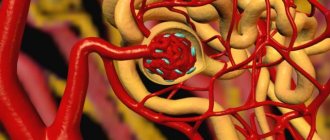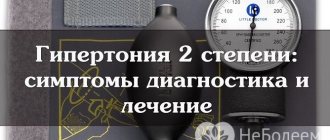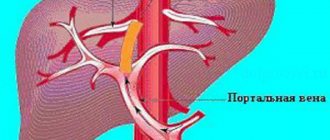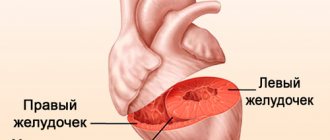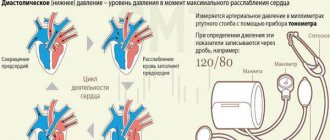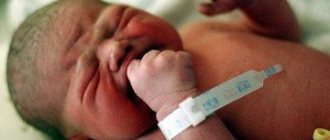What is diastolic hypertension
The disease is characterized by an increase in blood pressure to levels of 140 to 90 mm. RT Art. Also, pathology can be diagnosed when the difference between systolic and diastolic pressure is 20 units.
When blood pressure readings are above 140/90 this is the initial form of hypertension
In this case, the upper indicators, as a rule, remain normal, and the lower ones increase. This condition is very dangerous for a person, because such a difference indicates a disruption in the functioning of the heart. It works in an enhanced mode, the vessels are under constant tension, which leads to their gradual destruction.
Factors and manifestations of increased performance
A slight increase in diastolic blood value (up to 90 mm Hg) is not dangerous. But this is provided that the person is in perfect health.
But when a patient, in addition to hypertension, has pathologies such as diabetes, kidney disease, obesity, atherosclerosis, a previous myocardial infarction or thyroid adenoma, increased diastolic pressure is a sign that heart problems are brewing.
In this case, the diseases listed above that provoke an increase in diastolic blood pressure should be treated.
If a person does not suffer from the above diseases, then all that he should do at first is to control blood pressure and change his lifestyle:
- go to bed earlier;
- do not drink red wine;
- don't smoke too much;
- do not be nervous;
- eliminate salt from the diet;
- maintain normal weight;
- do physical exercise (not sports) or yoga.
It is generally accepted that an increase in diastolic pressure occurs for similar reasons to systolic hypertension.
- Features of the body that are determined by the presence of similar diseases in blood relatives.
- Drinking large amounts of alcohol and nicotine.
- Excess weight and frequent overeating.
- Lack of systematic physical activity.
- Constant stress, overwork.
- Complex diseases in chronic form.
- Kidney disease and pancreatic dysfunction.
- Large amounts of salt in food.
But it must be taken into account that with all these coincidences there is no age factor.
- bleeding from the nose;
- deterioration in vision clarity;
- persistent headache;
- difficulty breathing and shortness of breath.
If a person begins to experience these symptoms, they should immediately seek medical attention within a few days.
It is recommended that all people have preventive blood pressure measurements.
Causes and clinical picture
Many factors can influence the onset of the disease. Most often it occurs due to disorders of the cardiovascular system. In addition, systolic-diastolic arterial hypertension may appear as a result of:
- Kidney and liver dysfunction;
- Atherosclerotic vascular lesions;
- Diabetes mellitus and obesity (any stage);
- Frequent nervous and physical stress;
- Abuse of bad habits;
- Irregular and unbalanced diet;
- Past severe viral and infectious diseases;
- Endocrine system disorders;
- Age-related changes in the body.
In childhood, diastolic hypertension is diagnosed, as a rule, due to genetic predisposition or unfavorable living conditions.
Blood pressure disorders in a child may be associated with the conditions in which he lives
In teenagers, this may be a consequence of hormonal changes in the body or frequent worries. If we talk about the clinical picture, the disease is accompanied by various symptoms that significantly worsen the patient’s condition and prevent them from living a full life.
Note. In children, diastolic hypertension is more severe than in adults and quickly becomes severe.
Symptoms may not appear all at once, but gradually. In this case, it is important to recognize the pathology in time and contact a pediatrician in order to prevent irreversible consequences.
Diastolic hypertension and yoga
For diastonic hypertension, it is better to do yoga rather than exercise. And not with fitness yoga, which is now fashionable, but with performing real yoga poses.
Even doing just one – “Shoemaker’s Pose” – helps improve vascular tone much better than hour-long exercise in the gym.
To perform this asana, you should sit in the cobbler's pose, and then slowly bend forward (as shown in the video) and return to the starting position. There is no need to force yourself to take the correct position - this will come with time. The main thing, in this case, is to start.
by Alla-Maria
Systolo-diastolic hypertension
As mentioned above, with this pathology, consistently high blood pressure is observed, with the upper values usually remaining at 140 mm. Hg, and the lower ones rise to 90 units. Diastolic hypertension has several forms and is divided into:
- Labile - a temporary increase in blood pressure due to external factors (stress, overwork, sedentary lifestyle, etc.). Most often, therapeutic measures are limited to lifestyle adjustments, elimination of bad habits and the use of diet therapy. Medicines are used only if these measures fail to normalize blood pressure.
- Stable - constantly high blood pressure due to pathological processes occurring in the body. Preventive measures in this case are powerless; treatment occurs with the help of medications.
Healthy eating, sports, good rest, positive emotions are the best care for your health.
The first (mild) form is less safe, but requires special attention. If aggressive factors that influence changes in indicators are not eliminated in time, the disease may progress to the chronic stage. Signs of pathology include:
- Excessive fatigue;
- Sleep disorders;
- Labored breathing;
- Regular pain in the back of the head and crown of the head;
- Ringing in the ears and darkening of the eyes.
In this condition, a person’s performance decreases and mental activity deteriorates. This interferes with normal living, due to which the hypertensive person experiences excessive irritability or, conversely, becomes apathetic.
Symptoms of the disease
Systole-diastolic arterial hypertension does not always manifest itself clearly. but if the pathological process has gone too far, then the patient develops the following symptoms:
- Constant fatigue, general weakness, decreased vitality, muscle weakness.
- Deterioration in performance.
- Problems falling asleep and staying asleep in general.
- Headache, dizziness.
- Increased irritability, nervous excitability.
- Noise in ears.
If the lower limit of pressure has risen to 100 mm Hg, then a person may experience nausea and vomiting, shortness of breath, sharp pain in the chest, and increased heart rate. The nose may bleed.
Isolated diastolic hypertension
Isolated diastolic arterial hypertension, as a rule, is genetic in nature. At the same time, high blood pressure levels are observed on an ongoing basis. The upper ones, as a rule, reach 140 units, and the lower ones rise to 90 or more.
The risk group includes people who are overweight, who experience frequent, severe stress and overwork, as well as those who abuse addictions and have various diseases that occur in a severe or chronic stage.
The danger of isolated diastolic hypertension is that it cannot always be recognized in the first stages, since there are either no symptoms or they are minor. Only in a few cases do patients complain of:
- Regular headaches;
- Constant fatigue and drowsiness;
- Sudden nosebleeds;
- Feeling of chest tightness.
In order to prevent the development of complications, when the first symptoms are detected, it is necessary to see a doctor as soon as possible and begin a course of treatment.
Diastolic arterial hypertension ⋆ Heart Treatment
Diastolic hypertension is a disease that develops as a result of circulatory disorders.
The pathology is characterized by an increase in lower blood pressure, which in the absence of timely treatment can lead to serious consequences.
To understand the danger of the disease, you need to know the etiology of its development, the main clinical symptoms, as well as methods of diagnosis and treatment.
Letters from our readers
Topic: Grandma's blood pressure has returned to normal!
From: Christina (
The causes of increased diastolic pressure can be completely different. And the answer to the question of why such pressure arose and how to treat it can only be given by a doctor. Initially, you need to see a therapist.
If secondary hypertension is suspected, specialized specialists are involved in the treatment and examination of such a patient: cardiologist, nephrologist, endocrinologist.
Symptoms of isolated diastolic hypertension may be absent for a long time, but sometimes appear in a rather acute form:
- headache and dizziness;
- weakness;
- nausea and vomiting;
- blurred visual perception.
Causes of secondary hypertension
Why is the lower one elevated and the upper one normal?
The heart continues to work normally, the force of its ejection remains the same. This explains the normal systolic pressure. The vessels are responsible for diastolic blood pressure. Its high level indicates that the vessels are narrowed or have lost their elasticity. This is a consequence of a number of reasons:
- increased tone of arterial vessels due to external stress or pathological changes in the mechanism of nerve impulse transmission;
- increased release of biological active substances that have a pressor effect (norepinephrine, serotonin, renin, etc.);
- weakening of the mechanisms of depressant action;
- atherosclerotic changes in the walls of blood vessels.
Possible complications
If you start the recommended treatment on time, the prognosis is usually favorable and an improvement in well-being is noted almost immediately. If symptoms are ignored and there is no therapeutic measures, the disease progresses and leads to a number of complications. These include:
- Liver failure;
- Hemorrhages and rupture of blood vessels;
- Acute heart and kidney failure;
- Abdominal aortic aneurysm.
In addition, due to oxygen starvation of brain cells, dangerous pathologies associated with the central nervous system can occur.
Note. The disease can develop over a long period of time, but complications, as a rule, arise instantly.
Anything can happen due to improper functioning of the heart, so timely consultation with a doctor will help avoid serious consequences, including death.
Is treatment required?
With a mild form of primary diastolic hypertension, complete recovery can occur if treatment is started on time and a healthy lifestyle is maintained. If the increase in pressure is caused by improper functioning of the kidneys or endocrine system, then healing the organ that caused the pathology can also lead to general recovery. But such a development of events is only possible with early diagnosis of the primary disease and timely treatment.
If the disease that provoked the appearance of isolated diastolic hypertension is completely cured, then the need for constant treatment of hypertension will also disappear. You will only need to constantly monitor your blood pressure readings and prevent them from increasing.
However, hypertension, especially isolated diastolic hypertension, is often recognized too late, when complications appear. It is also not always possible to completely eliminate the cause of the disease. Then treatment is necessary and can be lengthy. If the disease has become irreversible, you will have to be treated with medication for the rest of your life.
Traditional Treatments
Before prescribing a particular drug, the doctor conducts a complete examination of the patient. Most often, general and biochemical tests of blood and urine, electrocardiography of the heart, Dopplerography (vascular examination), etc. are prescribed.
Only after a thorough examination, the doctor prescribes drug therapy.
Based on the obtained tests, various medications are prescribed. The table shows the drugs that are prescribed most often.
| Type of medicine | Name of the medicine |
| Diuretics | "Furosemide", "Hypothiazide", "Torasemide" |
| Calcium antagonists | "Verapamil", "Corinfar", "Nifedipine" |
| ACE inhibitors | "Zocardis", "Captopril", "Lotensin". |
| Beta blockers | "Acridilol", "Vedicardol", "Acebutolol". |
| Drugs that relieve symptoms | Antispasmodics, antiemetics, antiarrhythmics and others. |
The combination and groups of medications may change, since the treatment method is selected individually. If the increase in blood pressure is caused by stress and disorders of the nervous system, then sedatives and tranquilizers can be prescribed.
In case of heart rhythm disturbances, drugs are used to normalize it. Self-medication with hypertensive and antihypertensive drugs is strictly prohibited. Uncontrolled use of medications most often only worsens a person’s condition and leads to serious consequences.
Effective treatment
Treatment of diastolic hypertension is prescribed by a general practitioner or cardiologist! The treatment regimen is selected individually.
A healthy lifestyle serves as a good preventative and therapeutic remedy for the disease. You should pay attention to moderate physical activity, maintaining your weight at a normal level, and giving up the habit of puffing on cigarettes. It is better to limit the consumption of alcoholic beverages and salt in your daily diet.
When a diagnosis is made, the patient is offered treatment in a hospital. Under these conditions, it is easier to find out the cause of the disease and prescribe an adequate course of treatment. In cases where the cause of diastolic hypertension is a malfunction of the aortic valve, the patient may undergo surgery.
Medicines are selected individually for each patient.
To treat this type of hypertension, medications with a diuretic effect, ACE inhibitors or beta-blockers may be prescribed. Therapy is carried out under the supervision of the attending physician.
Example: Hydrolasine lowers diastolic blood pressure. The drug is prescribed in doses of 10 - 20 mg three times a day. Another medicine, Isobarine, lowers the tone of small arteries. Gradually reduces diastolic blood pressure and increases blood volume in the veins. A properly selected set of medications will lower blood pressure and improve blood circulation.
Treatment with folk remedies
Traditional medicine often helps to cope with various pathologies, including hypertension. Recipes include many different tinctures and decoctions.
Recipes for folk remedies for hypertension are quite wide: herbal teas, bitters, delicious mixtures of dried fruits
The most effective for high blood pressure are:
- Tincture of soothing herbs. Mix 1 tbsp. l valerian, 2 tbsp. l motherwort, 2 tbsp. l peony and 1 tbsp. l lemon balm. Mix the ingredients thoroughly, take 1 tbsp. l, place the mixture in a glass and pour 200 ml of boiling water. The medicine is infused for one hour, taken 3 times a day, 1 tablespoon.
- A decoction to normalize blood pressure. Grind one onion, 5 cloves of garlic, add 1 tbsp. l hawthorn fruits, rose hips and dill seeds. Next, the ingredients are transferred to a saucepan and filled with one liter of water. After this, the medicine must be boiled for 10 minutes, cooled, strained and stored in the refrigerator. The product is taken 2-3 times a day, 1 tbsp. l until blood pressure returns to normal.
- High blood pressure drink. Pour mineral water into a glass and release the gases. Then add half a teaspoon of lemon juice, one teaspoon of honey and a pinch of dried ginger. Mix the ingredients thoroughly and consume on an empty stomach. Recommended daily intake 400 ml.
Freshly squeezed vegetable and fruit juices have good properties. For hypertension, cardiologists recommend drinking beet juice mixed in half with carrot, pumpkin or squash.
Important! Hypertension is a rather complex disease that requires the selection of an individual treatment regimen. You cannot do this on your own; it is better to entrust this procedure to a cardiologist. Only he will be able to select the right groups of drugs and recommend the necessary preventive measures.
General principles of treatment
If diastolic hypertension develops, treatment must be comprehensive. Drug therapy, folk remedies and maintaining a correct lifestyle are mandatory. The general principles of therapy are:
- Compliance with dosages of medications prescribed by the doctor. You cannot change them or stop taking medications on your own.
- You should not use medications on your own, as they can further worsen the patient’s condition.
- Walk more in the fresh air.
- Do morning exercises, perform feasible physical exercises.
- Eat properly.
- Quit alcoholic drinks and smoking.
Only careful adherence to the recommendations will help restore normal blood pressure. If the patient ignores these tips, his condition will gradually worsen.
In case of a hypertensive crisis, first aid can be provided to the patient before the doctors arrive. To do this, place him face down on his stomach, and apply a cold compress to his neck. After half an hour, it can be removed, and oil or cream is applied to this place. You need to massage the neck area without pressure.
How is it diagnosed?
Systolic-diastolic arterial hypertension can be detected through a general examination of the patient and questioning him about disturbing clinical manifestations. To confirm the diagnosis, blood pressure is monitored throughout the day. It is also important to do an ultrasound diagnosis of the heart and kidneys to exclude possible pathologies of these organs. It is recommended to conduct magnetic resonance and computed tomography of the brain and undergo a general and biochemical blood test.
Increased blood pressure most often occurs after stress or significant physical activity.
Characteristic symptoms
Manifestations of diastolic hypertension are insignificant. Due to the absence of symptoms, it is diagnosed as part of a medical examination. Characteristic symptoms are the result of the prolonged influence of a number of factors; they are not spontaneous. These include:
- general malaise;
- decreased performance;
- frequent headaches;
- the appearance of ringing in the ears (tinnitus);
- fatigue syndrome;
- obvious weakness;
- sleep problems;
- visual impairment;
- apathy;
- aggression and exaggerated anxiety;
- dizziness;
- nosebleeds (at very high values, more than 100 units).
It is important to consult a specialist when the first suspicious symptoms appear. Initial symptoms may be minimal. But in the absence of proper treatment, a feeling of fear, anxiety, and increased heart rate appears. In such cases, you will need to undergo a full examination to determine the stage and characteristics of the disease.
Symptoms may vary depending on the indicators. So, with a slight increase, within 10 units, manifestations may be completely absent. But with systo-diastolic arterial hypertension, when the lower pressure values exceed 90 and above, blurred vision, severe headache, nosebleeds, and shortness of breath appear.
Drug treatment
Drug treatment of isolated diastolic arterial hypertension is complicated by the fact that most drugs reduce both lower and upper pressure. It is necessary to begin therapy by eliminating the pathology that contributes to the development of hypertension. Most often, treatment is carried out in an inpatient setting.
Therapy with antihypertensive drugs
The following antihypertensive drugs are used in the treatment of diastolic hypertension:
- Beta blockers (Timolol, Lokren). They prevent the flow of adrenaline into the heart, muscle tissue relaxes, and the volume of blood ejected decreases. Treatment begins with the administration of a minimum amount of medication, and the dose is gradually increased until a therapeutic effect is achieved.
- Calcium antagonists (Isoptin, Gallopamil). The active substances prevent the entry of calcium into the cells of the arteries and heart muscle.
- ACE inhibitors (Berlipril, Enap). Medicines suppress the production of certain enzymes, improving vascular permeability and increasing their elasticity. You need to take medications under the supervision of a doctor.
Angiotensin II receptor blockers
Medicines in this group (Losartan, Candesartan) restore left ventricular function, improve the quality of life of hypertensive patients, and eliminate signs of heart failure (shortness of breath, wheezing behind the sternum). Regular use of drugs increases resistance to stress. Taking medication for systolic-diastolic arterial hypertension depends on the time of increase in pressure. If signs of hypertension appear mainly in the evening, tablets are taken after lunch. Angiotensin receptor blockers are contraindicated in:
- pregnancy and lactation;
- dehydration of the body;
- decreased potassium levels in the blood;
- individual intolerance to active and auxiliary substances.
Diuretic drugs
Diuretics are taken in combination with other medications. They are used for uncomplicated disease. Thiazide diuretics have a mild hypotensive effect. The drugs Hydralazine and Spironolactone reduce the risk of stroke and heart attack and prevent renal dysfunction. Uncontrolled use of diuretics can provoke arrhythmia.
How to quickly lower low blood pressure at home?
The following recipes are recommended as additional therapy for diastolic hypertension:
- blood pressure lowering drinks . You can regularly drink freshly squeezed beet juice with honey, viburnum compote, as well as raspberry and currant drinks. Tea is also made from the fruits of plants;
- hawthorn infusion . The flowers of the plant are poured with boiling water in a percentage ratio of one to ten, left for half an hour, and drunk a quarter glass before meals;
- tea made from dark grape leaves . Drink the drink in small portions throughout the day;
- motherwort grass . It is poured with boiling water, taking 2 parts of it and ten water, infused, filtered and drunk in small sips throughout the day;
- tea mushroom . Effective for normalizing blood pressure, relieving headaches and heart pain;
- infusion of white acacia flowers . One spoon is poured into a glass of boiling water, infused and consumed half a glass three times a day;
- dill infusion . Pour two tablespoons of seeds into a liter of boiling water, infuse, take ½ cup three times a day.
Diuretic herbs have a quick effect for normalizing diastolic hypertension: birch leaves, burdock, lingonberry, juniper, horsetail, string, bearberry.
Traditional medicine recipes, as well as fresh air and normal sleep will help prevent hypertension.
Causes of pathology
The reasons for the increase in diastolic pressure most often cannot be found. The doctor diagnoses primary or essential hypertension.
Some studies confirm the development of essential pathology against the background of hormonal imbalance, salt reabsorption in the kidneys, and the detection of vasoconstrictor substances in the blood. All these provoking factors can be hereditary or acquired. For example, when consuming a lot of salt.
We can talk about secondary hypertension if it develops against the background of another disease or is a side effect when taking medications.
The most common causes of the secondary form of the disease:
- kidney pathologies;
- adrenal tumor;
- renovascular hypertension;
- pheochromocytoma;
- increased blood pressure during pregnancy;
- side effects of drugs.
Blood pressure can rise sharply with frequent alcohol consumption and under the influence of stress.
The risk of increased diastolic blood pressure increases sharply with:
- unfavorable heredity;
- obesity;
- presence of bad habits (alcohol, smoking);
- strong physical activity;
- physical inactivity;
- increased blood viscosity;
- atherosclerosis of the coronary vessels of the heart;
- disruption of metabolic processes in the body;
- diseases of the endocrine system;
- excess calcium and sodium in the blood.
If a single case of increased diastolic pressure is recorded, then the diagnosis of “Diastolic hypertension” is not made. The exception is those cases when the indicators are very high, for example, 170/105 or 180/110 mmHg.
To confirm the diagnosis, blood pressure is measured regularly over a specified period of time. Attention is drawn to the circumstances under which blood pressure levels increase. For example, stress, drinking coffee, smoking a cigarette.
What are the causes of the disease
The following causes contribute to the development of diastolic hypertension:
- diseases of the excretory system (atherosclerosis of the renal vessels, glomerulonephritis), in which substances are produced that increase the tone of the vascular walls and narrow the lumen of the arteries;
- pathologies of the thyroid gland, in which the concentration of thyroid hormones increases, affecting the functioning of the cardiovascular system;
- retention of excess fluid in the body, caused by improper functioning of the kidneys, changes in hormonal levels, and consumption of salty foods.
Risk factors include:
- obesity (considered the main cause of high blood pressure);
- bad habits (smoking, alcohol abuse);
- low physical activity;
- poor nutrition;
- psycho-emotional overload;
- increased level of low-density lipoproteins in the blood;
- diabetes.
Features of treatment
Therapy for systolic-diastolic arterial hypertension consists of eliminating the cause of increased blood pressure. It is also important to maintain blood pressure at a certain normal level. For this purpose, lifelong use of antihypertensive drugs is indicated. The most commonly used beta blockers are Metoprolol or Bisoprolol. ACE and calcium channel blockers, calcium and renin antagonists are also used. It is imperative to use potassium-sparing diuretics, which help remove excess fluid from the bloodstream. Vitamin-mineral complexes and angioprotectors are recommended.

